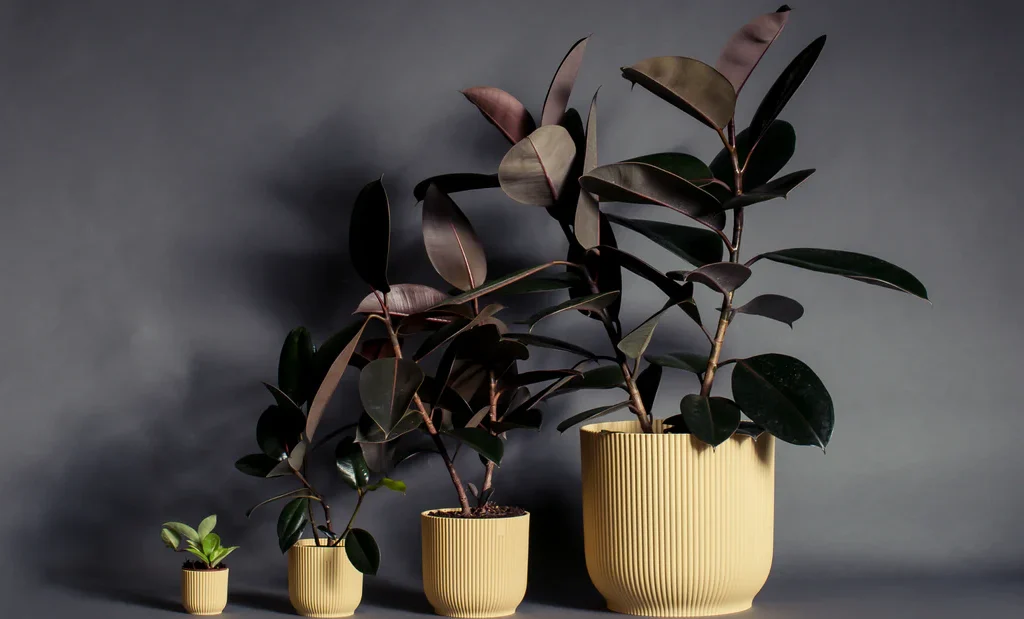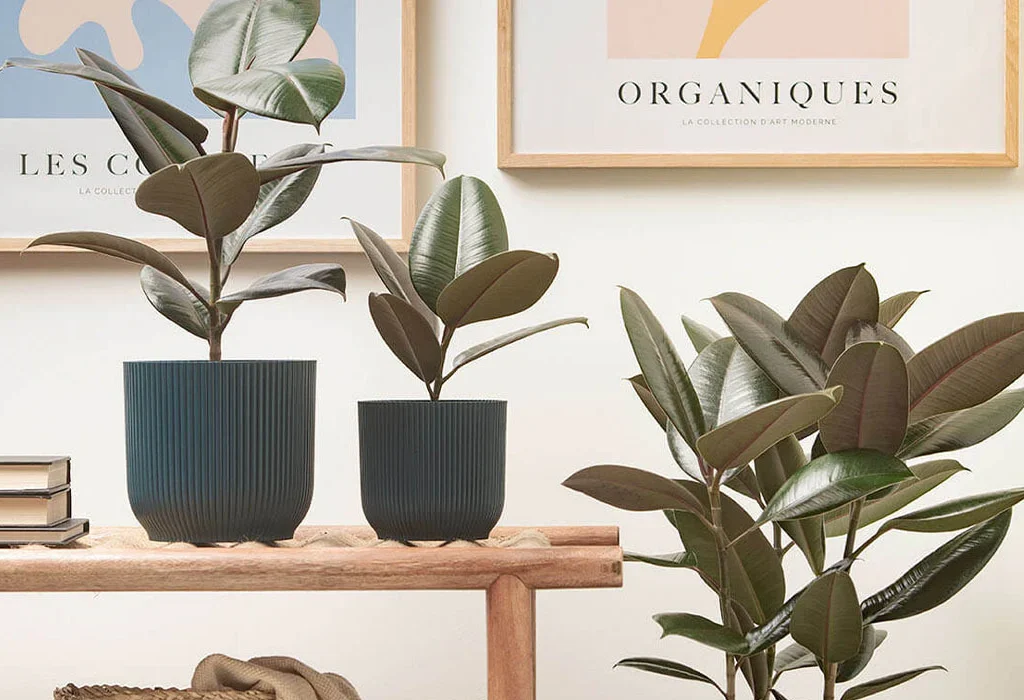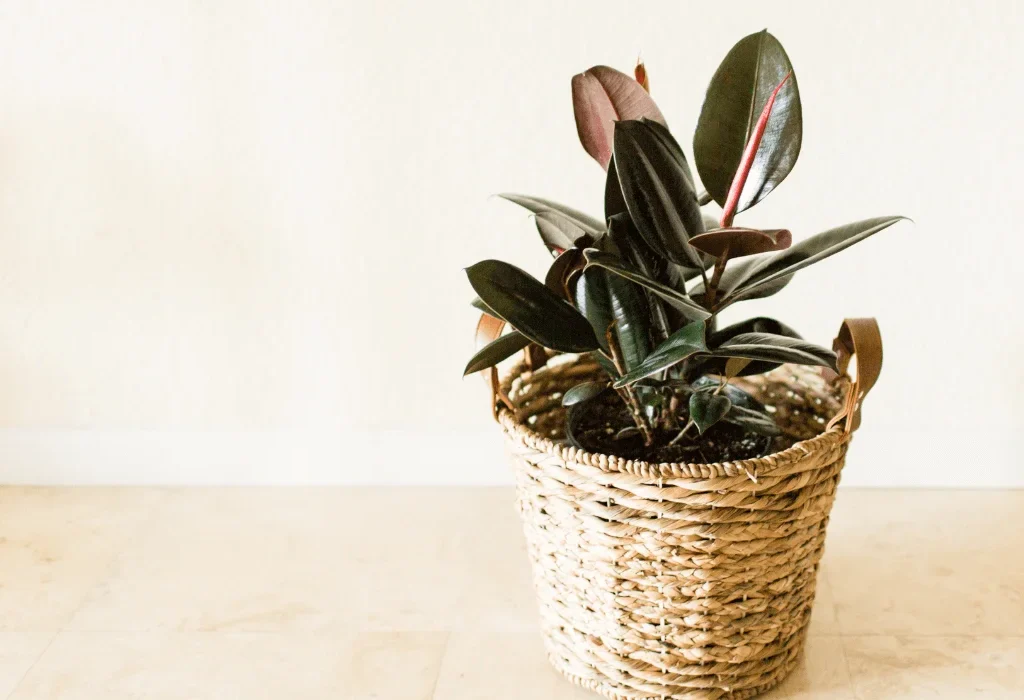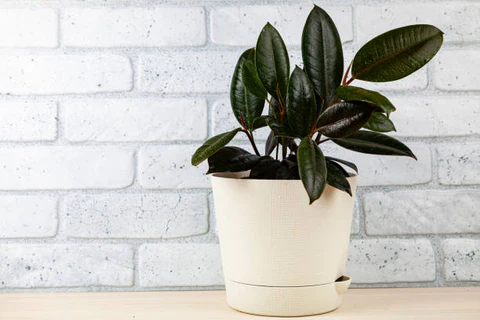If you’re looking for a houseplant that’s both elegant and easy to care for, the Rubber Plant might just be your perfect pick. With its broad, glossy leaves and upright growth habit, the Rubber Plant adds a touch of tropical charm to any room. And the best part? It’s surprisingly beginner-friendly.
In this detailed guide, we’ll cover everything you need to know about how to care for a Rubber Plant, from lighting and watering to pruning and troubleshooting. Whether you’re new to plant parenting or simply adding to your indoor jungle, this guide will help you keep your Rubber Plant happy and thriving.

What Is a Rubber Plant?
The Rubber Plant (scientific name Ficus elastica) is a popular houseplant native to Southeast Asia. It belongs to the fig family (Moraceae) and is known for its thick, leathery leaves that can range in color from deep green to burgundy, depending on the variety.
In its natural habitat, the Rubber Plant can grow up to 100 feet tall. Indoors, however, it usually stays between 3 to 10 feet, making it a striking statement plant for homes and offices.
Popular Rubber Plant varieties include:
- Ficus elastica ‘Robusta’ – Classic deep green, glossy leaves.
- Ficus elastica ‘Burgundy’ – Dark purple-green leaves with a reddish tint.
- Ficus elastica ‘Tineke’ – Cream and green variegated foliage.
- Ficus elastica ‘Ruby’ – Pink-tinted variegated leaves.

Why Choose a Rubber Plant?
There are plenty of reasons why Rubber Plants are a favorite among plant enthusiasts:
- Low-maintenance: Easy for beginners with basic care.
- Air-purifying: Helps remove indoor toxins like formaldehyde.
- Visually bold: Its large, shiny leaves instantly elevate any space.
- Adaptable: Can thrive in different lighting and humidity conditions.
- Fast-growing: With the right care, it can grow several inches per year.

How to Care for a Rubber Plant for Beginners
Though relatively fuss-free, Rubber Plants do have some preferences. Here’s a complete, beginner-friendly care guide to help your Rubber Plant thrive indoors.
1. Light Requirements
Rubber Plants love light but prefer it bright and indirect.
- Ideal placement: Near an east-facing or south-facing window with filtered sunlight.
- Too much direct sun: Can scorch the leaves, causing browning.
- Low light: Will slow growth and cause leaves to drop.
Tip: If your Rubber Plant’s leaves look dull or if it leans towards the window, it might need more light.
2. Watering Routine
Rubber Plants like to dry out slightly between waterings.
- When to water: Allow the top 1-2 inches of soil to dry before watering again.
- Water thoroughly: Water until it drains out of the pot’s bottom, then discard excess water.
- In winter: Reduce watering frequency as the plant’s growth slows.
Signs of overwatering: Yellowing leaves, mushy stems, or root rot.
Signs of underwatering: Drooping or dry, crispy leaves.
Pro tip: Use room-temperature, filtered, or rainwater to avoid chemical sensitivity.
3. Temperature and Humidity Needs
Rubber Plants thrive in warm, humid environments.
- Ideal temperature: Between 65°F to 80°F (18°C to 27°C).
- Avoid cold drafts, heaters, or AC vents that can cause leaf drop.
- Humidity: Prefers moderate humidity but tolerates normal indoor levels.
How to boost humidity:
- Mist the leaves occasionally.
- Use a pebble tray with water beneath the pot.
- Group it with other humidity-loving plants.
- Run a small humidifier nearby if your air is very dry.
4. Soil and Potting Tips
Rubber Plants need well-draining, slightly acidic soil.
- Best soil mix: Use an indoor potting mix combined with perlite or coarse sand for better drainage.
- Pot selection: Always choose a pot with drainage holes to prevent root rot.
Repot every 2-3 years or when roots become cramped. Spring is the best time for repotting.
5. Fertilizing for Growth
Feed your Rubber Plant regularly during its active growing months.
- When to fertilize: Every 4-6 weeks in spring and summer.
- Fertilizer type: Use a balanced, water-soluble houseplant fertilizer diluted to half strength.
- In fall and winter: Pause fertilizing as the plant rests.
Tip: Over-fertilizing can damage roots. If unsure, it’s better to underfeed than overfeed.
6. Pruning and Maintenance
Pruning helps control the size of your Rubber Plant and encourages fuller growth.
- When to prune: Late spring or early summer.
- How to prune: Use sterilized scissors to trim stems just above a leaf node.
- Remove yellowing or damaged leaves as needed.
Bonus tip: Pruning cuttings can be propagated to grow new plants.
Warning: Rubber Plants release a milky sap when cut. It can irritate skin, so wear gloves and wash your hands after pruning.
7. Propagation Methods
Want to multiply your Rubber Plant? Propagation is easy, even for beginners.
Steps for stem cutting propagation:
- Cut a healthy stem just below a leaf node.
- Remove lower leaves, leaving 1-2 at the top.
- Dip the cut end in rooting hormone (optional).
- Plant the cutting in moist soil or place it in water.
- Keep in a warm, bright spot and maintain humidity.
Roots usually develop within 3-6 weeks.
8. Common Rubber Plant Problems and Solutions
| Problem | Cause | Solution |
|---|---|---|
| Yellowing leaves | Overwatering | Check soil moisture, reduce watering |
| Drooping leaves | Underwatering, draft exposure | Water properly, move away from drafts |
| Leaf drop | Sudden temperature changes | Keep in stable, warm conditions |
| Brown leaf tips/edges | Low humidity or underwatering | Increase humidity, mist leaves |
| Pests (spider mites, scale) | Dry air, poor airflow | Wipe leaves with insecticidal soap |

Styling Ideas for Your Rubber Plant
Thanks to its striking foliage, the Rubber Plant makes a perfect décor accent.
- Corner statement: Tall varieties look stunning in living room or bedroom corners.
- Desk or tabletop: Young plants in decorative pots add character to workspaces.
- Bathroom greenery: Loves the humidity of bathrooms, provided there’s enough light.
- Paired with baskets: Place the pot in a woven basket for a chic, natural look.
Fun Facts About Rubber Plants
- In the wild, Rubber Plants can grow aerial roots that support their massive trunks.
- The latex sap was once used to make rubber, though it’s not the primary source today.
- NASA listed Rubber Plants among its top air-purifying indoor plants.
Final Thoughts
The Rubber Plant is a fantastic choice for beginners looking for a low-maintenance, visually appealing houseplant. With its dramatic, glossy leaves and forgiving nature, it quickly becomes a favorite in any indoor garden.
By providing the right balance of light, water, warmth, and occasional pruning, you’ll enjoy a healthy, vibrant Rubber Plant that can grow for years — even decades. Whether you’re starting your first houseplant collection or expanding your green space, the Rubber Plant is a reliable, easy-care companion you won’t regret bringing home.
Ready to add one to your space? Follow this care guide, and your Rubber Plant will reward you with beauty, cleaner air, and plenty of compliments from guests.





Leave A Comment